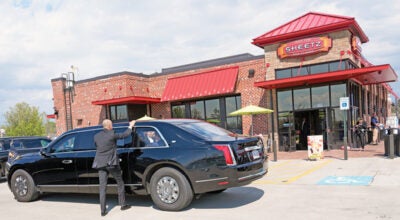Tears for the passing of Mr. Focus
Published 8:00 am Saturday, January 30, 2021
I had tears this week.
Not that I don’t care about all of the ones that we lose, but I have protective mechanisms set up to protect me until it is nighttime. Then it is too late for tears.
Mr. Focus got through those protections.
Most of my Facebook friends have seen photos and videos of my small falcon friends. Focus has been with me about a year, but still retains much of her independence and has a somewhat saucy manner. (Before you go out and capture a desk falcon, you need to have a falconry permit. To get a falconry permit, you must pass a written exam and facilities inspection and have a sponsor lined up to coach you. What looks like fun is a lot of work!)
Kestrels are the smallest North American falcon and the most common.
They are actually the smallest American raptor, a bird of prey. They are about 10 inches in length with a 22-inch wingspan.
They live in open country, farmland, cities and wood edges. In open country, they can be seen perched on fences, overhead wires or hovering low over a field. All they seem to need is prey and some raised perches.
During the breeding season, they need appropriate nesting sites. These can be tree cavities or nesting boxes.
Kestrels can be easily sexed by their color differences. Both sexes have a white with black- spotted belly and flanks, red or roufus wings and tail, but the blue-grey outer wings of the males are quite distinct.
The female tail is more of the rufous color, but both have numerous narrow dark black bars that can give an indication of age. (More bars mean an older kestrel.)
Both sexes have a head that is white with a bluish-grey top. Kestrels have two narrow, vertical black facial markings on each side of the head. (Other falcons only have one.)
Most of a kestrel’s diet consists of mostly large insects such as grasshoppers, dragonflies, beetles, moths and caterpillars and small animals like lizards, mice, voles, and small birds. Although they have been reported to have killed snakes, bats, and even squirrels.
Given the opportunity, they will eat frogs, earthworms, spiders, crayfish and other items. Part of the reason kestrels are common is because of the broad scope of diet.
Typically, a kestrel will perch and wait for prey to come near. This is why you can see them along roadsides or fields perched on objects such as trees, overhead power lines or fence posts.
However, the bird that you see kiting (hovering in the air with rapid wing beats) and scanning the ground for prey is a kestrel. They are one of the few birds that can hover.
Typically, they will catch their prey on the ground, although they can take birds in flight.
Many raptors have a variable focus lens that they focus by bobbing their head up and down. A kestrel that has chosen prey will bob its head and tail, then make a direct flight toward the prey and then grab it in its talons. They will then bite the back of the neck for a quick kill.
Kestrels live from the Arctic Circle to the tropics of Central America.
They live in elevations the Andes Mountains to the coasts. They range from northern Canada to the southernmost tip of South America. The kestrels that live in the north typically migrate south in the winter. They sometimes go as far as Central America and the Caribbean. Birds that breed south of about 35° north latitude are usually year-round residents. A really cold year can encourage migration, while a warmer year might mean more birds hang around all winter.
The American kestrel’s scientific name, Falco sparverius, refers to the falcate, or hooked, shape of the beak, and kestrel’s small size and hunting of sparrows as a typical prey.
Kestrels are also called sparrow hawks, mostly because they look a lot like the Eurasian sparrowhawk, but we now know they are more closely related to the larger falcons. Other colloquial names include grasshopper hawk (think diet) and killy hawk (think distinct call).
Kestrels differ from other falcons in that they are leaner with less muscle.
The flight muscles take up less of the body weight compared to the stronger flying falcons such as the peregrine. The wings are moderately long, fairly narrow, and taper to a point. The lower muscle percentage is ideal for their energy-conserving ambush hunting. Larger falcons need more muscle for the energy-consuming time on the wing and the long tail-chases of bird prey.
Just because they are small does not mean they do not have strong talons and beaks.
I have seen Focus swiftly dispatch prey that is almost as big as her. Her flight may not be as swift and dramatic as a more muscular falcon, but they are perfectly sized for the more available smaller prey. They also need less food per day. All of these things contribute to the fact that there are many more kestrels about than the larger falcons.
Focus will often kestrel cuss me with her klee, klee, klee, klee when she is upset or excited. Kestrels also make a “whine” and the “chitter.”
The “whine” call is mostly used during feeding, but is also uttered during copulation. The “chitter” is used between male and female birds, including courtship feeding, copulation and the feeding of nestlings. Nestlings start talking like the adults at 16 days old.
The females are slightly larger than the males, but there is not as much difference as with other hawks and falcons. The female may be 10–15 percent larger than the male. Northern birds are larger than the southern birds.
When Focus was trapped, she was 134 grams. Mr. Focus was starving and in bad shape when he was brought in on rehab and was 51 grams. Within two days, had gained 20 grams. By the third day, he was flying to the glove and was up to 81 grams and I was beginning to have thoughts of the pair hunting together and maybe breeding. (You have to have a separate permit for that!)
American kestrels are cavity nesters, but they are able to adapt to a wide variety of nesting situations. Natural cavities like trees are preferred. A closed top and tight fitting entrance provides maximum protection for the eggs and young. Kestrels will nest in holes created by large woodpeckers, abandoned nests of other birds, such as red-tailed hawks, merlins and crows. They will commonly use nesting boxes. Occasionally they have been known to nest on cliff ledges and building tops.
While a Harris hawk will not mature to breed for three or four years and peregrines until their second year, American kestrels are sexually mature by their first spring.
Usually, the males set up a territory and the female selects a mate. They typically mate for life and use the same nesting sites in consecutive years. This means they already know the hunting grounds, neighbors, predators and other features of the site.
In courtship, males perform elaborate dive displays to advertise their territory and attract a mate. There may be several climbs and dives, with three or four “klee” calls at their peaks.
The female flies slowly with stiff, fluttering wingbeats, the wings held just below horizontal. Females may mate with multiple males for about one to two weeks after their arrival at the nesting site. It may be that this stimulates their ovulation. The male will transfer food to the female while flying prior to egg laying.
The female will typically lay four or five eggs, each one to three days apart. Their eggs are about 10 percent larger than a similarly sized bird. The cream-colored eggs have brown or grey splotching and are incubated about 30 days. Most of the time the female incubates, but the male will help 15–20 percent of the time.
The eggs hatch over a three to four-day period. The hatchlings are unable to even sit up for five days. Although they will start to eat, they mostly use the yolk sac during these first few days. They grow rapidly and reaching their adult weight after 16–17 days. By four weeks to a month, their wings have developed to the point they are able to leave the nest. Mom and dad will still feed them for a few weeks while they learn to hunt.
A kestrel in the wild is likely to only live three to five years. A captive kestrel can live up to 14–17 years. Almost half of the deaths are caused by humans by direct killing and road kills. Predation (including by larger birds of prey) only accounts for about three percent. (This may be biased, because as reported deaths are usually found near humans.)
Because they eat live prey, kestrels can concentrate toxic chemical runoff that was ingested by their prey. They seem to have an altered immune response because of ingestion of polybrominated diphenyl ethers (PBDEs). PBDEs are a group of industrial flame retardants that may leach from factories into the environment. An accumulation of PBDE in kestrels inhibits the T-cell mediated immune response. That means the kestrels that ingest PBDEs cannot respond sufficiently to viruses or other invading microorganisms. Habitat decline and longleaf pine removal has also resulted in an 82 percent decline in the southeast population since 1940.
Kestrels are also used in falconry. Since they are common, they are even considered a beginner’s bird.
I have found they are anything but a beginner’s bird. The skill required to maintain the careful weight control needed to maintain the kestrel’s desire to aggressively hunt is sometimes beyond my time allowed to falconry.
All of my other birds have been easier to maintain than Focus.
I had high hopes for Mr. Focus though. The first hours that he was in, he ate from a tongue depressor while I held him and he rapidly progressed as he gained weight.
Rusty said he looked down and out a few mornings, but his weight kept going up and he was gaining strength until Wednesday.
Then he was seizuring when I went to get him.
Emergency treatment did not help him and he went in and out of seizures for the next couple of hours. He was comfortable when I left late that night, but I knew in my heart that he would be gone in the morning.
I probably should have euthanized him, but I could not bring myself to do it.
Perhaps because I know there is no one else to care about this individual bird or that I know pets are cared for and loved by their families, but I cried most of the way home.
RIP, Mr. Focus.
MJ Wixsom, DVM MS is a best-selling Amazon author who practices at Guardian Animal Medical Center in Flatwoods, Ky. GuardianAnimal.com 606-928-6566.






